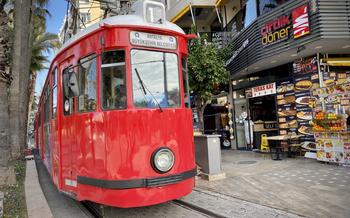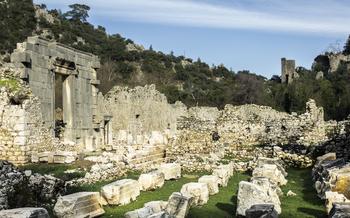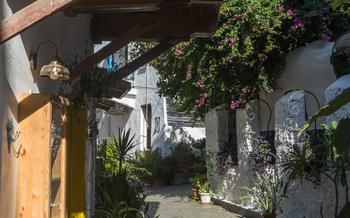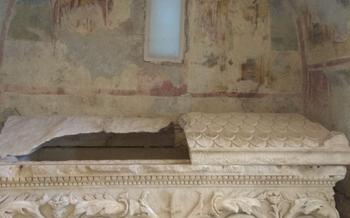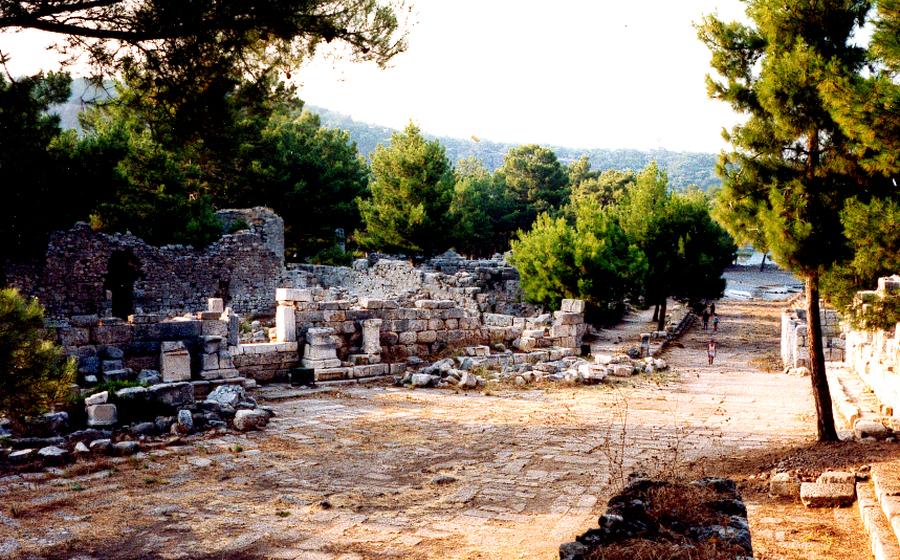
Phaselis Ancient City
- Phaselis Ancient City: A Journey Through Time
- Unveiling the History of Phaselis
- Exploring the Ruins of Phaselis
- Strolling Along the Picturesque Harbor
- Admiring the Well-Preserved Theater
- Discovering the Agora and Its Surroundings
- Unearthing the Secrets of the Necropolis
- Relaxing on the Pristine Beaches
- Indulging in Local Delicacies
- Shopping for Souvenirs and Handicrafts
- Taking a Boat Tour to Nearby Islands
- Exploring the Olympos Beydaglari National Park
- Visiting the Ancient City of Olympos
- Learning About the Chimaera Myth
- Insider Tip: Discovering Hidden Gems
Phaselis Ancient City: A Journey Through Time
Situated along the mesmerizing turquoise coast of Antalya, Turkey, Phaselis Ancient City beckons travelers to embark on a captivating journey through history. Founded in the 7th century BC by Greek colonists from Rhodes, Phaselis flourished as a prominent trading hub and naval power, connecting the East and the West. Nestled amidst picturesque landscapes, where the Taurus Mountains gracefully meet the Mediterranean Sea, Phaselis offers a treasure trove of ancient ruins, pristine beaches, and cultural experiences, inviting visitors to delve into its rich and storied past.
The best time to visit Phaselis is during the shoulder seasons, from April to May and from September to October, when the weather is pleasant, and the crowds are smaller. The ancient city is easily accessible by car or public transportation, making it a convenient day trip from Antalya or Kemer.
Unveiling the History of Phaselis
Phaselis was founded around the 7th century BC by Greek colonists from Rhodes and Crete. It quickly rose to prominence as a major trading hub due to its strategic location at the crossroads of the Mediterranean Sea and the land routes to the East. The city flourished during the Hellenistic and Roman periods, becoming a thriving center of commerce and culture.
Phaselis played a crucial role in trade and commerce, linking the East and the West. Its harbor was a bustling hub for merchant ships carrying goods from around the Mediterranean and beyond. The city's merchants traded a wide range of products, including olive oil, wine, timber, and slaves. Phaselis also served as a center for the minting of coins, further solidifying its economic importance.
Throughout its history, Phaselis interacted with various civilizations, including the Persians, the Macedonians, and the Romans. These interactions left a lasting impact on the city's culture and architecture. The city's coins, for example, often featured images of Greek gods and goddesses, as well as local deities.
In the 7th century AD, Phaselis was abandoned due to a combination of factors, including Arab raids, earthquakes, and the rise of the Byzantine Empire. The city's population dwindled, and its once-thriving harbor fell into disuse. The ruins of Phaselis were gradually swallowed by the forest, and the city's legacy faded into obscurity.
Exploring the Ruins of Phaselis
The ruins of Phaselis lie scattered across a vast area, offering a glimpse into the city's glorious past. The layout of the city is clearly discernible, with the main thoroughfares leading to the harbor and the agora. Notable landmarks include the well-preserved theater, the agora, and the necropolis.
The theater is a marvel of ancient engineering, with its intricate acoustics and seating capacity of over 2,000 people. It was once the stage for theatrical performances, musical concerts, and political assemblies. Today, it occasionally hosts cultural events and performances, allowing visitors to experience the theater's timeless charm.
The agora, or marketplace, was the bustling heart of commercial activity in Phaselis. Here, merchants traded goods from far-flung lands, and locals gathered to buy and sell everyday necessities. The agora is surrounded by the remains of shops, warehouses, and administrative buildings, providing a glimpse into the city's economic and political life.
The necropolis, or cemetery, lies on a hill overlooking the city. Here, the final resting places of Phaselis's citizens have been preserved for centuries. The tombs vary in size and style, from simple graves to elaborate mausoleums. Inscriptions and carvings on the tombs offer insights into the lives and beliefs of the people of Phaselis.
Strolling Along the Picturesque Harbor
In ancient times, the harbor of Phaselis played a crucial role in the city's maritime trade and commerce. Today, it stands as a picturesque reminder of the city's past glory. The harbor is surrounded by towering cliffs and lush vegetation, creating a breathtaking backdrop for a leisurely stroll.
The current state of the harbor is one of serene tranquility. The water is crystal clear, reflecting the vibrant colors of the surrounding landscape. Fishing boats and yachts bob gently on the waves, adding a touch of life to the otherwise tranquil scene.
There are several activities and attractions to enjoy in the harbor area. Visitors can take a leisurely walk along the promenade, admiring the stunning views and soaking in the fresh sea air. There are also several cafes and restaurants lining the harbor, offering a variety of culinary delights and refreshments.
For photography enthusiasts, the Phaselis harbor presents a wealth of opportunities to capture stunning images. The combination of the ancient ruins, the tranquil waters, and the dramatic cliffs provides a picturesque backdrop for any shot. With careful planning and a bit of patience, visitors can capture images that will serve as lasting mementos of their time in Phaselis.
Admiring the Well-Preserved Theater
Phaselis' theater is an architectural masterpiece that has stood the test of time. Built in the Hellenistic period, it boasts remarkable acoustics, with a seating capacity of over 2000 spectators. The theater's design allows sound to carry clearly throughout the auditorium, making it an ideal venue for performances and speeches.
Today, the theater is still used for cultural events and concerts, offering visitors a unique opportunity to experience the magic of ancient Greek theater. Imagine sitting on the worn stone steps, surrounded by the echoes of history, as you witness a performance that transports you back in time.
Behind the scenes, the theater holds many stories and anecdotes. Actors and musicians share tales of their experiences performing in this ancient space, while historians delve into the rich history of the theater and its significance in the cultural life of Phaselis.
Discovering the Agora and Its Surroundings
The agora, the bustling marketplace and social center of ancient Phaselis, stands as a testament to the city's vibrant commercial and civic life. Located at the heart of the city, the agora served as a meeting place, a place for trade, and a venue for political and religious gatherings.
As you step into the agora, you'll be greeted by a vast open space surrounded by colonnaded stoas, or covered walkways. These stoas provided shelter from the sun and rain and housed shops, stalls, and workshops where merchants sold their wares. From fresh produce and handcrafted pottery to exotic spices and imported goods, the agora was a hub of economic activity.
Among the notable buildings within the agora is the bouleuterion, the council chamber where the city's leaders met to discuss and decide on important matters. The bouleuterion features a well-preserved seating arrangement and offers a glimpse into the democratic processes of ancient Phaselis.
In the vicinity of the agora, you'll find several other significant structures, including temples dedicated to various deities. The Temple of Athena, the patron goddess of the city, is particularly noteworthy for its impressive size and intricate architectural details. Its ruins evoke a sense of reverence and spirituality that transport you back in time.
As you explore the agora and its surroundings, keep an eye out for artifacts and inscriptions that provide clues about the daily life and customs of Phaselis' inhabitants. From commercial contracts and legal documents to religious dedications and funerary inscriptions, these remnants of the past offer valuable insights into the rich history and culture of this ancient city.
Unearthing the Secrets of the Necropolis
Situated on a gentle slope overlooking the Mediterranean Sea, the necropolis of Phaselis offers a glimpse into the funerary practices and beliefs of this ancient city. Its location outside the city walls, as was customary in many ancient civilizations, speaks to the profound respect accorded to the dead. The necropolis contains a diverse array of tombs, reflecting the social hierarchy and cultural influences that shaped Phaselis over the centuries.
The most elaborate tombs belong to the wealthy and powerful, featuring intricate carvings, decorative facades, and inscriptions detailing their accomplishments and lineage. These grand mausoleums stand as testaments to the enduring legacy of Phaselis' elite. In contrast, the simpler tombs, often marked by humble headstones or earthen mounds, provide insights into the lives of ordinary citizens.
Among the notable tombs in the necropolis, the "Painted Tomb" stands out for its exquisitely preserved frescoes depicting scenes from mythology, daily life, and religious rituals. These vibrant paintings offer a rare glimpse into the artistic traditions and beliefs of the Phaselites. Another significant tomb is the "Sarcophagus Tomb," which features an intricately carved marble sarcophagus depicting a reclining figure surrounded by funerary symbols.
The necropolis of Phaselis is not merely a collection of tombs but a repository of stories and traditions that shed light on the cultural and spiritual values of this ancient city. As visitors wander among the ruins, they can't help but feel a sense of connection to the past, a reminder that even in death, the legacy of Phaselis lives on.
Relaxing on the Pristine Beaches
The allure of Phaselis extends beyond its ancient ruins, encompassing a picturesque coastline dotted with pristine beaches. These idyllic havens, easily accessible from the city center, offer a respite from historical exploration and a chance to soak up the Mediterranean sun.
The main beach, aptly named Phaselis Beach, is a popular choice for its crystal-clear waters, soft golden sands, and gentle waves. Flanked by lush greenery and backed by the imposing Taurus Mountains, this beach provides a breathtaking backdrop for a relaxing day by the sea. Visitors can bask in the warm sunshine, build sandcastles, or take a refreshing dip in the azure waters.
For those seeking a more secluded experience, secluded coves and hidden beaches can be found along the coastline. A short hike or boat ride will lead to tranquil spots where one can escape the crowds and enjoy the tranquility of nature. Whether seeking solitude or lively beachside activities, Phaselis offers a diverse range of options for beach enthusiasts.
Amenities such as sun loungers, umbrellas, and beach bars are available at the main beach, ensuring a comfortable and convenient experience. Lifeguards are also present during the peak season, ensuring the safety of swimmers.
To avoid the midday heat and crowds, consider visiting the beaches early in the morning or late in the afternoon, when the sun is less intense. Remember to pack essentials like sunscreen, hats, and beach towels to make the most of your beach day in Phaselis.
Indulging in Local Delicacies
The culinary scene in Phaselis is an alluring blend of traditional Turkish flavors and Mediterranean influences, offering a diverse range of dishes that tantalize the taste buds. To fully immerse yourself in the local gastronomy, be sure to savor the mouthwatering specialties that have become synonymous with this region.
Traditional Dishes and Culinary Specialties:
-
Mezze Platters: Begin your culinary journey with a delightful array of mezzes, an assortment of small plates that showcase the region's diverse flavors. Indulge in hummus, baba ghanoush, stuffed grape leaves, and a variety of dips accompanied by freshly baked bread.
-
Grilled Meats: Savor the succulent flavors of grilled meats, a cornerstone of Turkish cuisine. Choose from tender lamb chops, juicy kebabs, or aromatic chicken skewers, all expertly seasoned and cooked to perfection over an open flame.
-
Seafood Delights: With its proximity to the Mediterranean Sea, Phaselis offers an abundance of fresh seafood. Relish the sweet taste of grilled octopus, savor the delicate flavors of sea bass or sea bream, or indulge in a traditional Turkish fish stew.
-
Vegetarian Options: Phaselis caters to vegetarians with a variety of delicious and satisfying dishes. Explore the vibrant flavors of stuffed vegetables, hearty lentil soups, and an assortment of fresh salads showcasing the region's bountiful produce.
Recommended Restaurants and Eateries:
-
Ali Baba Restaurant: This family-run restaurant serves authentic Turkish cuisine in a warm and welcoming atmosphere. Enjoy traditional dishes such as manti (Turkish ravioli) and güveç (clay pot stew) while soaking in the local ambiance.
-
The Harbor Fish House: Located on the picturesque harbor, this restaurant specializes in fresh seafood. Choose from a variety of grilled fish, calamari, and shrimp, all accompanied by stunning views of the Mediterranean Sea.
-
Meze by Lemon Tree: For a taste of contemporary Turkish cuisine, head to Meze by Lemon Tree. This stylish restaurant offers a creative twist on traditional dishes, using local and seasonal ingredients to create innovative and mouthwatering creations.
Street Food Options and Local Markets:
-
Street Food Delights: Don't miss the opportunity to sample the delectable street food offerings in Phaselis. Indulge in freshly baked simit (sesame bread), gözleme (savory stuffed flatbread), and döner kebabs, a Turkish culinary staple.
-
Local Markets: Immerse yourself in the vibrant atmosphere of Phaselis' local markets. Browse stalls laden with fresh fruits, vegetables, spices, and traditional Turkish sweets, and engage with friendly vendors who are passionate about their products.
Shopping for Souvenirs and Handicrafts
Phaselis offers a treasure trove of unique souvenirs and handicrafts that reflect its rich history and culture. From intricately woven carpets and hand-painted ceramics to traditional jewelry and leather goods, there's something for every taste and budget.
The best place to start your shopping journey is the charming Old Town, where you'll find an array of shops and boutiques lining the narrow streets. Here, you can browse through colorful textiles, decorative pottery, and handmade accessories, each piece imbued with the artistry and craftsmanship of local artisans.
Don't miss the opportunity to visit the bustling bazaar, where vendors display their wares under colorful canopies. Here, you can haggle for a bargain on everything from spices and dried fruits to souvenirs and clothing. Remember, bargaining is a part of the local culture, so don't be afraid to engage in friendly negotiations.
If you're looking for unique and authentic items, head to the local workshops and studios, where you can watch artisans create their masterpieces. You can find everything from hand-blown glass ornaments to intricately carved wooden sculptures, each piece a testament to the skill and creativity of the local craftsmen.
Remember to support the local community by purchasing directly from the artisans. Your purchases not only contribute to their livelihoods but also help preserve the traditional crafts and skills that have been passed down for generations.
Taking a Boat Tour to Nearby Islands
Phaselis's strategic location on the Mediterranean Sea makes it an ideal starting point for exploring the picturesque islands that dot the coastline. Several boat tour operators offer excursions to these idyllic destinations, allowing visitors to discover hidden coves, pristine beaches, and ancient ruins.
One of the most popular islands to visit is Kekova, renowned for its sunken city. The ruins of ancient Simena lie just beneath the crystal-clear waters, offering a unique opportunity to snorkel or dive among the submerged structures. The island is also home to a charming fishing village, where visitors can savor delicious seafood dishes and soak up the laid-back atmosphere.
Another must-visit island is Demre, formerly known as Myra. This historic island boasts an impressive collection of Lycian rock tombs, including the renowned Tomb of St. Nicholas. The island is also home to the Church of St. Nicholas, dedicated to the patron saint of sailors and children, which attracts pilgrims and history buffs alike.
Boat tours to these islands typically depart from the harbor of Phaselis. Visitors can choose from various tour options, ranging from half-day excursions to full-day adventures. Most tours include swimming stops, allowing participants to cool off in the refreshing Mediterranean waters.
To ensure a memorable boat trip, it's advisable to book in advance, especially during the peak tourist season. Visitors should also consider packing swimwear, sunscreen, a hat, and comfortable shoes for exploring the islands.
Exploring the Olympos Beydaglari National Park
Located just a short distance from Phaselis, the Olympos Beydaglari National Park offers a breathtaking natural retreat for those seeking adventure and tranquility. Established in 1972, the park encompasses a diverse landscape of towering mountains, lush forests, and pristine beaches, providing a haven for a rich variety of flora and fauna.
Natural Wonders, Flora, and Fauna:
The park's diverse ecosystem is home to an array of plant and animal species, including rare and endangered species. Visitors can marvel at the ancient cedar and pine forests, spot elusive wildlife such as the Anatolian leopard and brown bear, and encounter a kaleidoscope of colorful butterflies and birds.
Hiking Trails and Scenic Viewpoints:
Outdoor enthusiasts will delight in the park's extensive network of hiking trails, ranging from leisurely strolls to challenging treks. The trails wind through picturesque landscapes, offering panoramic views of the Mediterranean Sea, the Taurus Mountains, and the verdant valleys below.
Opportunities for Camping and Outdoor Activities:
The park provides designated camping areas for those seeking an immersive experience in nature. Visitors can pitch their tents under the starry sky, enjoy picnics by the river, and embark on exciting activities such as mountain climbing, caving, and wildlife watching.
Tips for Visiting the Olympos Beydaglari National Park:
- Plan your visit during the spring or fall for the most pleasant weather conditions.
- Wear comfortable shoes and bring plenty of water, especially if you plan to hike.
- Be aware of the park's regulations and safety guidelines, including restrictions on camping and open fires.
- Respect the park's natural environment and wildlife by avoiding littering and noise pollution.
Visiting the Ancient City of Olympos
Olympos, an ancient city located just a short distance from Phaselis, shares a deep historical connection with its neighboring counterpart. Once a significant port city and a member of the Lycian League, Olympos thrived as a center of trade and commerce. Its ruins, nestled amidst a stunning natural landscape, offer a glimpse into the rich history of the region.
Visitors to Olympos can explore the well-preserved remains of the city, including its impressive fortifications, temples, and theaters. The main attraction of Olympos is the acropolis, which offers panoramic views of the surrounding mountains and the Mediterranean Sea. Other notable landmarks include the Temple of Apollo, the Agora, and the Necropolis, where visitors can see a variety of tombs and sarcophagi.
Combining a visit to Phaselis with a trip to Olympos is an excellent way to delve deeper into the history and culture of ancient Lycia. These two ancient cities, situated in close proximity, offer a unique opportunity to explore the interconnectedness of the region's past.
Learning About the Chimaera Myth
In the realm of ancient mythology, Phaselis is intertwined with the captivating tale of the Chimaera, a mythical creature with a lion's head, a goat's body, and a serpent's tail. According to legend, the Chimaera terrorized the region until the hero Bellerophon, mounted on the winged horse Pegasus, vanquished the beast.
The Chimaera Flames, a Natural Wonder
The Chimaera's legacy lives on through the mesmerizing Chimaera flames, a natural phenomenon found near the ruins of Phaselis. These eternal flames, fueled by escaping gases from the earth's crust, flicker and dance against the backdrop of the ancient city, creating an ethereal and awe-inspiring sight.
Safety Precautions and Local Legends
While observing the Chimaera flames, visitors should exercise caution, as the flames can emit intense heat and sulfurous fumes. It is advisable to keep a safe distance and avoid touching the flames.
The Chimaera flames have captivated the imaginations of locals and visitors alike, inspiring a wealth of legends and stories. Some believe that the flames are the breath of the slain Chimaera, while others see them as a symbol of the eternal struggle between good and evil.
An Unforgettable Experience
Witnessing the Chimaera flames is an unforgettable experience that transports visitors to a realm of myth and legend. As the flames dance and flicker against the backdrop of the ancient ruins, one cannot help but feel a connection to the past and the enduring power of storytelling.
Insider Tip: Discovering Hidden Gems
Beyond the well-known landmarks, Phaselis holds a treasure trove of hidden gems waiting to be discovered by curious travelers. One such gem is the secluded beach of Koru Plajı, nestled amidst lush greenery and crystal-clear waters. Escape the crowds and immerse yourself in the tranquility of this pristine paradise.
For history buffs, venture off the beaten path to the Phaselis Museum, housing a collection of artifacts and inscriptions that shed light on the city's rich past. Gain insights into the daily lives and customs of the ancient inhabitants.
Don't miss the Mosaic Museum, showcasing beautifully preserved mosaics depicting scenes from mythology and everyday life. Admire the intricate craftsmanship and artistry that adorned the floors of Phaselis's buildings.
For a unique perspective, embark on a hike to the top of Mount Olympos, the highest peak in the region. Marvel at the panoramic views of Phaselis, the Mediterranean Sea, and the surrounding countryside. Capture breathtaking photos and create lasting memories.
Whether you seek tranquility, history, art, or adventure, Phaselis offers hidden gems that will captivate your senses and leave you with an unforgettable experience. Embrace the spirit of discovery and let the ancient city reveal its secrets to you.
